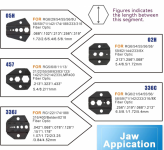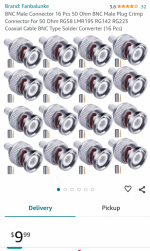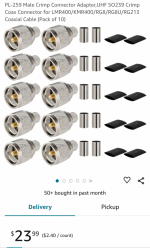Great....exactly the answer I wanted!Right, no soldering, no games, just properly done connections.
As the frequency drops, the performance gets better, so this will absolutely work on lower frequencies better than it will on higher frequencies.
LMR-400 is kind of stiff, so you may want a 90º fitting behind the wall plate if that's how you want to install it.
You are using an out of date browser. It may not display this or other websites correctly.
You should upgrade or use an alternative browser.
You should upgrade or use an alternative browser.
Hands down best RG8X?
- Thread starter K6GBW
- Start date
Looks great.....need to join a ham group and maybe borrow one from someone.....money is tight! I can't even take money out of my 401Ks because 85% of it's taxed.....BUT we won't go there.....Being somewhat ancient, I prefer to solder my connections. I use a Weller WESD soldering station with adjustable temps, 10 second heat time and a variety of tips.
I can understand IF there is training and they had great equipment for you to use......I've got 4 soldering irons but they are too weak except for my Weller (hasn't been used for 30 years and still in the box with a great new tip) but I plugged it in and put my finger on the tip and turned it on to see if it was going to heat up......got 123vac right up my arm! (so I'm NOT gonna use that!)I work for a very large telecom company, which includes cellular. If an employee or contractor is caught trying to solder on a coax connector, they would be escorted off the site and banned for life.
I just now noticed the "just drill the damn hole"Right, no soldering, no games, just properly done connections.
As the frequency drops, the performance gets better, so this will absolutely work on lower frequencies better than it will on higher frequencies.
LMR-400 is kind of stiff, so you may want a 90º fitting behind the wall plate if that's how you want to install it.
Compression connectors are all used by Spectrum (TW; Comcast....all the same now) cable now and I was told they were the least compromised by insertion loss & ingress.
I will be using this for mostly 1 MHz to 420 MHz and when looking at Times Microwave LMR UltraFlex or just LMR-400 specs seem to talk mostly UHF but if it's good enough for UHF can I "Assume" it will be fine for low frequencies? I will mostly be using this for my feedline and I will need enough bend to come up the wall and go into wallplate with pl-259 connections. Will I be able to bend it safely for this or should my feeding just go through wall or to a 90 degree connector for the back of the plate?
the Data sheet says that the minimum bend radius is 1" for a fixed bend (which doesn't sound right), 4" for repetitive bending.
(In the NASA std I referenced, they say 10 times the outside diameter is the minimum bend radius.)
and it shows the performance curve to 30 MHz, everything below that should be great..
The best part of this data sheet is it shows which connectors part numbers are appropriate (which is awesome !!! ).
Thanks
Joel
Is there a crimper you would suggest on Amazon? What wattage iron should I get? I'm now thinking crimp the shield connector and solder the center conductor.....afraid to crimp the center conductor w/o a professional crimper and besides the fittings are too expensive...Pre-made coax are almost always crimped. Its faster and not as labor intensive as soldering, and just as effective and reliable.
I make several a week with crimp tool with the appropriately sized dies. Search Amazon for radio coax crimp tool and you'll find several for
$22 to $52.For the occasional DIY I would solder.
For 1/2" and 3/" I use a stripping tool that does the job with a few twists.
Yes...think I'm going to use a 90 degree connector for the wall plate (bulkhead) in the wall to avoid the bend, exterior wall with lots of insulation!
the Data sheet says that the minimum bend radius is 1" for a fixed bend (which doesn't sound right), 4" for repetitive bending.
(In the NASA std I referenced, they say 10 times the outside diameter is the minimum bend radius.)
and it shows the performance curve to 30 MHz, everything below that should be great..
The best part of this data sheet is it shows which connectors part numbers are appropriate (which is awesome !!! ).
Thanks
Joel
mmckenna
I ♥ Ø
Is there a crimper you would suggest on Amazon? What wattage iron should I get? I'm now thinking crimp the shield connector and solder the center conductor.....afraid to crimp the center conductor w/o a professional crimper and besides the fittings are too expensive...
You'd only need/want something like a 30 watt iron, at the most. Too much heat and you'll damage the dielectric for these types of connectors.
If you were doing RG-8 and the old style UHF solder on connectors, you want something in the 250-300 watt range to get the heat in quickly. Not what you want to use for just the center pin on the crimp connectors.
Great....too bad my Radio Shack 30w needs a new tip.You'd only need/want something like a 30 watt iron, at the most. Too much heat and you'll damage the dielectric for these types of connectors.
If you were doing RG-8 and the old style UHF solder on connectors, you want something in the 250-300 watt range to get the heat in quickly. Not what you want to use for just the center pin on the crimp connectors.
So you think the shield crimp and center conductor solder will work well for occasional use....and if there is an emergency?
What watt or temp for soldering? Which will transfer heat to the dialectic faster solid or stranded center conductor? It would be nice if the center conductor was the center conductor vs crimp or solder (going back to the CATV days)......
A 40 watt iron will solder the center conductor nicely on the DXE "Next Generation" PL259s.
OTOH... with the CATV connector (known as a Type "F" connector) that you mention, the center conductor is the center pin.
They are easy to install and relatively cheap as is the RG6 coax. Actually, several of my ham antennas here are fed with RG6 using F connectors
(with appropriate adapters as necessary to mate with whatever). Don't worry too much about the 75 ohm thing as it really doesn't make a big difference in actual practice. But, this could open a whole another thread...
JustinWHT
Member
- Joined
- Apr 16, 2022
- Messages
- 225
This is what I bought couple of years ago from Amazon to replace my 20 year old crimp tool.Is there a crimper you would suggest on Amazon? ... I'm now thinking crimp ... afraid to crimp the center conductor w/o a professional crimper and besides the fittings are too expensive...
HKS Coax Ratchet Crimping Tool Set for Coaxial
RG Cable RF Connector with 5 Changeable Dies. $39
Attachments
JustinWHT
Member
- Joined
- Apr 16, 2022
- Messages
- 225
Pl-259 and BNC male crimp connectorsand besides the fittings are too expensive...
Attachments
JustinWHT
Member
- Joined
- Apr 16, 2022
- Messages
- 225
From the CAI blog....
 tinyurl.com
tinyurl.com
WEIGHING THE PROS & CONS OF THE TWO MOST POPULAR JOINING METHODS
Crimped connections are more flexible, heat-resistant and vibration-resistant than soldered ones which have greater potential for wire fatigue and stiffening. Crimping is often more consistent than soldering, which can vary according to method or technician. Meanwhile, the crimp-on process is simple, quick and easy to repeat when you know what you’re doing.
Properly crimped wire strands can create a “cold weld” in which the pressure is so great that the metals and their oxide layers form on a micro-level. That’s why crimping is the technique of choice in industries, such as aerospace and automotive, which demand the strongest, most reliable connections and can’t risk the degradation of filler metals.
Soldering or Crimping: Which Is Better for Your Electrical Needs? - CAI
Weighing the Pros & Cons of the Two Most Popular Joining Methods For a complex electrical system to run properly, its collection of wires, circuit board ...
WEIGHING THE PROS & CONS OF THE TWO MOST POPULAR JOINING METHODS
Crimped connections are more flexible, heat-resistant and vibration-resistant than soldered ones which have greater potential for wire fatigue and stiffening. Crimping is often more consistent than soldering, which can vary according to method or technician. Meanwhile, the crimp-on process is simple, quick and easy to repeat when you know what you’re doing.
Properly crimped wire strands can create a “cold weld” in which the pressure is so great that the metals and their oxide layers form on a micro-level. That’s why crimping is the technique of choice in industries, such as aerospace and automotive, which demand the strongest, most reliable connections and can’t risk the degradation of filler metals.
mmckenna
I ♥ Ø
Great....too bad my Radio Shack 30w needs a new tip.
So you think the shield crimp and center conductor solder will work well for occasional use....and if there is an emergency?
Yes it'll work. The last batch of RF Industries N connectors for RG-58 I purchased at work were solder center pin and crimp outer. My old Weller 30 watt iron worked just fine. I installed a bunch of radios in some transit buses with them.
Yes I used to think OHMs had to do with termination....I now understand it better. I used to "sweep" cable sections to find problems....but that was years ago....never really learned about impedance.A 40 watt iron will solder the center conductor nicely on the DXE "Next Generation" PL259s.
OTOH... with the CATV connector (known as a Type "F" connector) that you mention, the center conductor is the center pin.
They are easy to install and relatively cheap as is the RG6 coax. Actually, several of my ham antennas here are fed with RG6 using F connectors
(with appropriate adapters as necessary to mate with whatever). Don't worry too much about the 75 ohm thing as it really doesn't make a big difference in actual practice. But, this could open a whole another thread...
Thanks....will come back later with results!
Appreciate all of everyone's help!
JustinWHT
Member
- Joined
- Apr 16, 2022
- Messages
- 225
Sounds like a winding on the line side transformer is shorted to tip transformer..got 123vac right up my arm! (so I'm NOT gonna use that!)
I still have my Weller gun I bought in early 60's.
JustinWHT
Member
- Joined
- Apr 16, 2022
- Messages
- 225
Can we say "icky pic".It has a water displacement gel inside that helps keep water out when the jacket gets compromised.
TheDiablo
Member
The in house RG8X that DX Engineering sells is pretty good stuff.
Thanks....years ago I don't ever remember using 8x what I would call "Thin" or RG-59ish (Which when I was in CATV, got thrown out). I have no place to view (feel) the different cable but what I remeber using was RG-11ish size....I believe.The in house RG8X that DX Engineering sells is pretty good stuff.
Anyway, Bit the bullet and ordered LMR-400, I like the specs and least loss....
TheDiablo
Member
Thanks....years ago I don't ever remember using 8x what I would call "Thin" or RG-59ish (Which when I was in CATV, got thrown out). I have no place to view (feel) the different cable but what I remeber using was RG-11ish size....I believe.
Anyway, Bit the bullet and ordered LMR-400, I like the specs and least loss....
The next time I've gotta make up a length of 400 equivalent, I'm going to try the DXE stuff. If it's anything like the 8x, it will be very easy to work with.
Mostly done up BNC terminated cables that I keep in lengths of 25' for backpack coax up to 2 meters. There's loss, but not anything too too much at 25'.
I take my jacket and braid cut measurements the ghetto way, using an straight paperclip to eyeball the measurements inside the connector, and bending the paperclip to the desired depth for the cuts and measuring off of that. Cheap and effective.
Similar threads
- Replies
- 18
- Views
- 2K
- Replies
- 1
- Views
- 2K
- Replies
- 32
- Views
- 25K





